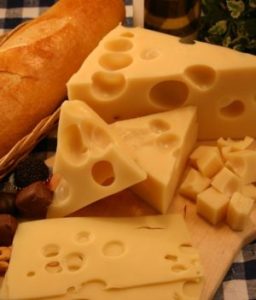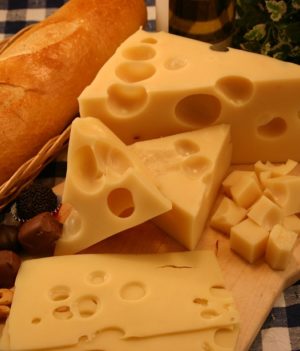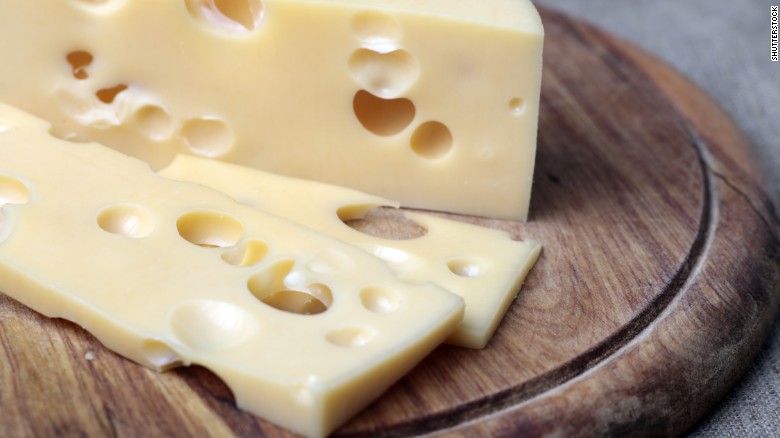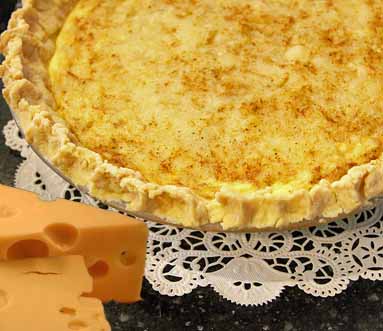Search Results for: swiss cheese
Natural Smoked Swiss Cheese
Natural Smoked Swiss Cheese
Natural Smoked Swiss Cheese. The same great taste of the swiss you love with that robust smokey flavor. Naturally smoked, instead of injected with smoke flavor this is a great option for persons looking for a less processed option of your favorite cheese.
Swiss Cheeses: Learn About Our Range
We stock a whole range of different Swiss cheeses here at Shisler’s Cheese House, so we thought now would be a great time to share them all with you.

How are Swiss Cheeses made?
The process of making Swiss cheeses involves natural bacteria consuming the lactic acid in the cheese. This releases carbon dioxide gas, which forms bubbles that become the holes in the cheese. These are often referred to as “eyes”.
Our range of Swiss cheeses
Our Ohio Swiss cheese is an Amish cheese made in Northeastern Ohio. It undergoes a longer aging process that it undergoes, at a higher temperature than younger cheeses. This produces larger eyes, which is sometimes seen as an indicator for better flavor. It closely resembles the original Swiss Emmental Cheese, which was originally produced in the Swiss canton of Bern. Ours has the signature nutty, bittersweet taste. The milk used in our Swiss cheese does not have preservatives added and is always from cows that have not been given hormones or antibiotics.
We also offer Baby Swiss, which substitutes water for the milk’s whey to slow the bacterial action. This creates smaller holes and a milder flavor, whilst still being delightfully creamy. If you or someone you love likes Baby Swiss cheese, then you’ll be pleased to know we offer a gift box with a 4lb. Baby Swiss cheese and a selection of assorted chocolates. You can also find a 2lb. Baby Swiss cheese in one of our other gift boxes, along with a Troyer’s Trail Bologna Ring, 8oz, of Colby Cheese, Shisler’s Private Label Mustard, Carr’s Crackers and assorted chocolates.
Lacy Swiss is another variety of Swiss cheese, made with low-fat milk. Lacy Swiss was invented by Alpine Lace Brands in 1985 in response to the growing need for healthier alternatives. This cheese is closely related to Swiss cheese, but the whole milk used to produce swiss cheese is replaced with low fat milk to provide a healthier alternative with a lower fat content. It gets its name from the lacy appearance of the slices, which usually have a creamy, ivory color to them. It has a delightfully light and nutty flavor. If you follow a lactose-free diet, then this cheese is naturally free of lactose.
We also stock Lacy Baby Swiss. Lacy Baby Swiss combines the production methods of Baby and Lacy Swiss to create a cheese with very small holes, a mild flavor, and a lower fat and sodium content than many cheeses.
We even offer smoked Swiss cheese and smoked baby Swiss. The smoked cheeses have a creamier texture and a more buttery, slightly sweet flavor, which make them ideal for melting. Light cold-smoking adds an earthiness to the flavor profile for an added smokey, cured taste.
Our final offering is a sharp Swiss cheese. This is a more mature version of our locally made cheese that has been aged for approximately 12 months. This is an excellent substitute for Gruyere cheese, if you prefer the more mature variety. The word ‘sharp’ denotes a strong flavor as a result of a long aging process.
How to enjoy Swiss cheeses
Swiss cheeses are delicious in a sandwich or served cut into cubes alongside salads and hams. They work well with most meats and are particularly good with a beef burger. You can use them in fondue and even enjoy them for breakfast with ham and a croissant. They pair well with apples, grapes, and pickled fruits and make an excellent addition to any cheeseboard.
How do you like to eat Swiss cheese? Let us know in the comments below!
Swiss Cheese: Everything You Need to Know

What is Swiss Cheese?
A holey, semi-hard cheese with a creamy color.
How does it taste?
It has a nutty, slightly piquant flavor whilst simultaneously being somewhat creamy.
How is Swiss Cheese made?
The process of making Swiss cheese involves natural bacteria consuming the lactic acid in the cheese. This releases carbon dioxide gas, which forms bubbles that become the holes in the cheese. These are often referred to as “eyes”. Our Amish swiss cheese, made in Northeastern Ohio, is especially flavorful because of the longer aging process that it undergoes, at a higher temperature than younger cheeses. This produces larger eyes, which is sometimes seen as an indicator for better flavor.
The milk used in our Swiss cheese does not have preservatives added and is always from cows that have not been given hormones or antibiotics.
We also offer Baby Swiss, which substitutes water for the milk’s whey to slow the bacterial action. This creates smaller holes and a milder flavor. Lacy Swiss is another variety of Swiss cheese, made with low-fat milk. We even offer smoked Swiss cheese.
How should I eat it?
Swiss cheese is delicious in a sandwich or served cut into cubes alongside salads and hams. It works well with most meats and is particularly good with a beef burger.
Use it as fondue or mix it into dips for a fun dinner party meal or appetizer.
For breakfast, eat a slice of it with ham in a croissant. You could even have fruit with it, as it has a nutty, caramel quality that complements apples and grapes well. It’s also very good with pickled fruits or vegetables. Consider adding them to your next cheeseboard for flavor and bite.
You could add an extra punch of flavor to your favorite mac and cheese by grating in some Swiss cheese. It is equally good with other pasta dishes, such as a creamy spaghetti or a linguine with vegetables. Use it with your breadcrumbs when making schnitzel for an extra crispy, cheesy bite.
What should I drink it with?
It goes well with Belgian ales or other creamy beers such as a pale ale. A light red wine such as Pinot Noir or Zinfandel won’t overpower the light flavor of the cheese but will bring out its sweetness. You may also find that crisp white wines such as Rieslings make a good companion for this cheese.
For a non-alcoholic option, an apple cider would be a good option as the apple flavors will offer a honey quality alongside the cheese.
How do you like to eat Swiss Cheese? Let us know in the comments!
5 Ways to Eat Swiss Cheese

We are huge fans of Swiss cheese here at Shisler’s Cheese House. We have a whole range to keep you happy and today we’re giving you 5 ideas for ways to enjoy Swiss cheese.
The process of making Swiss cheese involves natural bacteria consuming the lactic acid in the cheese. This releases carbon dioxide gas, which slowly forms bubbles that become the recognizable holes in the cheese. These are often referred to as “eyes”. Our Amish swiss cheese, made in Northeastern Ohio, is especially flavorful because of the longer aging process that it undergoes, at a higher temperature than younger cheeses. This produces larger eyes, which is sometimes seen as an indicator for better flavor.
The milk used in our Swiss cheese does not have preservatives added, and is from cows that have never been given hormones or antibiotics. This creates a great taste and you know exactly what you are eating.
We also offer Baby Swiss, which substitutes water for the milk’s whey to slow the bacterial action. This creates smaller holes and a milder flavor. Lacy Swiss is another variety of Swiss cheese, made with low-fat milk. We even offer smoked Swiss cheese.
- On Crackers
Swiss cheese is well known for its nutty, bittersweet taste. This is perfect enjoyed on your favorite crackers. Add a couple of other cheese, some grapes, and relishes, and you’ve got a full cheeseboard.
- Paired with your favorite wine or beer
This is such a versatile cheese that you can easily find a beverage pairing for it. If you’re a fan of red wines, try a Merlot or Pinot Noir. For white wine lovers, try a Chardonnay or Riesling. Swiss cheese will also pair well with lager, pale ales, and Weiss beer.
- Cheese Fondue
Fondue is a decadent treat that’s perfect at the end of a cold day, or to share with friends and family. Simmer 10 fl. oz. white wine in a fondue pot, before adding 10 oz. each of Swiss and Gruyere cheese. Make sure everything is melted before stirring in 2 teaspoons flour. Season with salt, pepper, and nutmeg. Serve this with cubes of your favorite bread, chopped vegetables, and cured meats.

- Mac and Cheese
Add an extra punch of flavor to your favorite mac and cheese by grating in some Swiss cheese. You can even add it to breadcrumbs for an extra crunchy topping.
- On French Onion Soup
A firm favorite for warming you up, French onion soup is incomplete without a topping of Swiss cheese toast. Thinly slice small pieces of your favorite bread, add grated Swiss cheese and grill before serving with your soup.
If you love Swiss cheese as much as us, why not treat yourself this to our gift box this Christmas? You’ll find a whole 4lb. Baby Swiss cheese, perfect to share with the whole family.
However you like to eat your Swiss cheese, you can find it all here at Shisler’s Cheese House!
The “hole” story behind Swiss Cheese… Get it?

For more than a century, the holes in Swiss cheeses such as Emmental have been attributed to carbon dioxide given off by bacteria. But that’s not the whole story, and now the Swiss have determined exactly why the holes form the way they do.
The culprit? Hay.
Pearl Valley Swiss Cheese… More than delicious, it’s Cheese Heaven!
Don’t have any weekend plans and want to take a nice road trip? Does your daily commute take you along US Route 30 through Orrville or Dalton, OH? If so, make sure to stop by the wonderland of cheese stores in the Great Lakes region, Shisler’s Cheese House. Known for its plethora of cheeses and delightful goodies, Shisler’s Cheese House will provide you with one of the best experiences you’ll have this side of the Mississippi.
Among the incredible amount of cheeses, our most famous is Pearl Valley Swiss. Pearl Valley Swiss comes from Fresno, OH, just south of Ohio’s Amish Country. Around since 1928, Pearl Valley Swiss has been an exemplary culinary artwork to all that have had the opportunity to taste this delicious masterpiece. Pearl Valley Swiss has a delightful, yet delicate flavor that cannot be mistaken with its rich, yet smooth flavor. Once you’ve had a bite of Pearl Valley Swiss at Shisler’s Cheese, you will have a new-found appreciation for cheese.
Where to find the gold, that is Pearl Valley Swiss Cheese in our store? Come on in and head straight to our cutting counter and you will see this brilliant display of Pearl Valley Swiss. We also do cheese cuts at your request! Only want a 1/2 lb. or 1/4 lb., we tailor to your requests. At 4.99/lb., you can’t go wrong taking some of this marvelous Swiss Cheese home with you today.
While you’re in the store, be sure to check out all of our other decadent goodies, from delicious cookies to a our large supply of Ben Heggy’s Chocolates to our Troyer’s Original Trail Bologna and other meats. Shisler’s Cheese House is your one-stop shop for a culinary experience you won’t soon forget!

Amish Country Swiss Cheese Fondue
There are countless recipes for fondue, but most contain some form of the original “Swiss” cheese. Many contain Emmentaler or Gruyere, but in today’s economic climate it is not always necessary to break the bank with expensive imports to impress your guests. The taste is what will impress them, and the best tasting fondue we’ve tried is made with Ohio’s Amish Country Swiss Cheese.
-
1 ½ Pounds of Grated Swiss Cheese
-
1 peeled fresh garlic clove
-
½ Pint of white wine
-
1 Ounce of kirsch
-
1 teaspoon of cornstarch
-
pepper, nutmeg, or paprika to taste
Serves 5 guests.
Enjoy Cooking with Baby Swiss cheese
There is nothing more satisfying than biting into a slice of semi-soft, young, fresh baby Swiss cheese made from whole milk. The characteristic small holes make this cheese all the more exciting and unique.
Baby Swiss cheese is a part of the Swiss cheese family that is known all over the world as the holey cheese. You can find this cheese at retail stores and delis, mostly in Ohio. To make it convenient for you to use it in sandwiches and other recipes, this cheese is sometimes sold pre-sliced. If you want it for larger cooking projects, you can buy baby Swiss cheese in wheels.
Swiss cheese is made from cow’s milk. Lactic acid in the cheese is broken down using bacteria to generate carbon dioxide which in turn results in the formation of bubbles during the process of aging. To obtain larger holes and complex flavors, the cheese is allowed to age for a longer time.
Many steps are altered during the cheese making process to make baby Swiss cheese. To obtain that exquisite, buttery rich flavor, whole milk is used to make the cheese. In order to slow down the bacterial digestion process, water is used to cut the milk. As compared to traditional Swiss cheese, baby Swiss cheese is aged for a shorter period of time to create the more mild flavor.
Bite into a bit of baby Swiss cheese and what will strike you first is its creamy, nutty and buttery flavor. This cheese is ideal to be used in a wide range of dishes and also melts quickly in the mouth. It is easier to work with this cheese as it comes with small holes and is easy to slice. The small holes make cooking with baby cheese enjoyable.
If you are planning to use this cheese for cooking purposes, it is essential choosing evenly colored ones with holes that are equally sized. The cheese should have a distinct buttery aroma and should resemble a pale straw. Before you buy the cheese, it is better to taste if the shop allows it as this is the only way to determine its quality. Otherwise, you must carefully observe for signs of cracking, mold and dampness. All these are indications that the flavor has been compromised.
Baby Swiss cheese can be layered with turkey, lettuce, ham, sliced onions and tomatoes on dark rye, light rye or wheat bread. Using this cheese you can make mouth-watering sauce for your steamed vegetables. Try the delicious French bread filled and baked until bubbly with chopped scallions and shredded baby Swiss. You can also enhance frittatas, omelets and quiches with this amazingly delicious cheese.
What’s your favorite use for Baby Swiss cheese?
History of Swiss Cheese
Of all of the cheeses we provide, our locally made Swiss is by far the most popular. As of this writing, we sell an average of 2,000 pounds per week, and triple that during the holiday season. Here is a story about the early history of what we call “Swiss Cheese.” For additional information on locally Made Swiss Cheese, check out our earlier post entitled Swiss Cheese or “Swiss” Cheese? Or Making Cheese the Amish Way.
Swiss cheese is the favourite of many due to its rich, delicious, mouth watering taste. Every single slice of this cheese is visually stimulating and come with large holes. These unique holes are created by adding gram positive bacteria to the starter culture. The carbon dioxide bubbles created by bacteria give holes to Swiss cheese. The bacteria are also responsible for the sweet and nutty taste of this cheese.
Walk into any of the cheese stores in Australia, United States, New Zealand or Canada and ask for Swiss cheese and you will get exactly that. You cannot guarantee this anywhere else in the world. For example, if you wish to purchase this mild tasting cheese with holes in Europe, you must ask for Emmental cheese. Swiss just refers to the origin and is not its name.
Emmental or Swiss cheese was first manufactured in West Central region of Switzerland. This region is also known as the Emmental area. This area is ideal for pastures with its large rolling fields. Emmental’s pastures were used by local farmers for thousands of years for dairy cattle grazing. A part of the milk obtained from the cows was used to make cheese.
Very soon, cheese became synonymous with Emmental. This cheese’s incredible taste and unique appearance was popularized by a writer through his series of novels on the Emmental dairy and cheese industry.
According to history, it was as early as 1300 that the Swiss cheese started to be produced in Emmental. It was however only in the 1800s that the first ever cheese dairies came into existence here. This in turn made the cheese very popular even with people who did not live in this region.
Gradually many dairies were developed in Emmental which resulted in the production of cheese in large quantities. Swiss cheese was then marketed to other areas and eventually all over the world.
Today, Swiss cheese is available throughout the world but visit Emmental and taste the cheese and you cannot miss the extra local flavour. Dairy farmers in Emmental are extremely choosy about what they feed their cows as they realize that the diet affects the final flavour of the cheese.
Cows, when they can graze in summers, live only on herbs, especially natural herbs. They are never fed silage. No farmer in Emmental has more than twenty cows, which allow them to care for them in such a manner that they produce the best quality milk.
In addition to our locally made Swiss Cheese, we also have our local Emmentaler, made by the original old world recipe.
Amish Country Swiss Cheese Pie
Here is a wonderful recipe with Amish Country Swiss Cheese as the principle element While there are many cheeses on the market that fall under the broad title of “Swiss Cheese”, including almost anything with holes at your local grocery store, we have found that the proper cheese will make or break the recipe. The mass-produced cheeses found at most grocery stores typically use chemicals to speed the aging process. But those chemicals of leave a metallic aftertaste to the cheese, which can negatively alter the taste of the pie. For anyone desiring a bolder flavor, trying substituting the Swiss cheese with Emmentaler or adding some sharp swiss into the mixture.
Ingredients
For the Crust:
- 1 ½ cups sifted cake flour
- 1 ½ teaspoon salt
With fingertips, work it until crumbly:
- 1/4 lb. butter or margarine (½ cup)
Slowly add, stirring with fork:
- 1/4 cup cold water
For the filling:
Fry until crisp:
- 12 slices of smoked bacon
- 1/4 lb. of grated Swiss cheese
Into bowl break:
- 4 eggs
then add:
- 2 cups of cream
- 3/4 teaspoon of salt
- Pinch of nutmeg
- Heavy pinch of sugar
- Pepper to taste
Preparation
Crust:
Shape the mixture into a ball and roll it in wax paper; chill it in the refrigerator, about 1/2 hour or until it’s easy to roll. Preheat the oven to 425°F. On a floured board, roll the dough into a large circle about 14 inches in diameter and fit it into 11” pie plate. Make a fluted edge as shown. Aerate the crust well with a fork. Place it in the refrigerator for about 30 minutes.
Filling:
Beat the mixture thoroughly with an egg beater. Take the piecrust from the refrigerator and rub the inside with 1 tablespoon of butter. Sprinkle the bacon bits, and then the grated cheese evenly in the bottom of the piecrust. Pour the cream mixture evenly over all.
Bake for 15 min., then reduce the oven temperature to 300°F, bake for 40 minutes longer or until a knife inserted into the center comes out clean.
Serve hot, cut into pie wedges.









